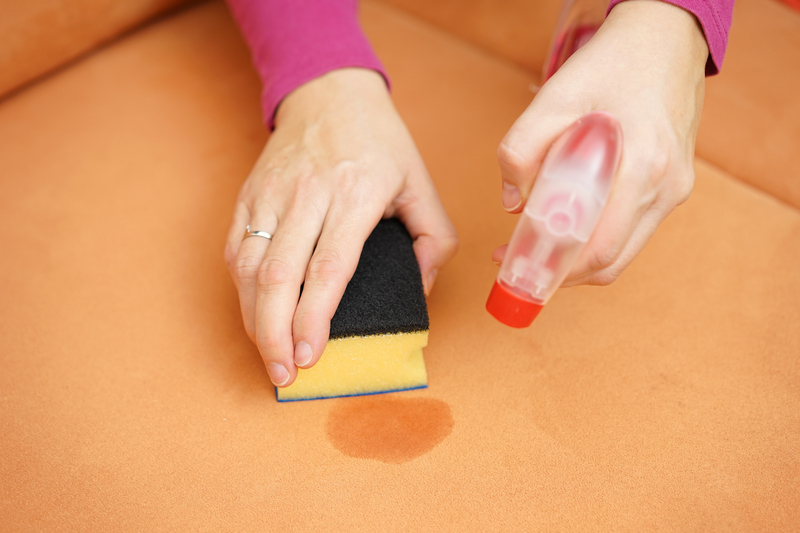Revitalize Your Windows: How to Clean Mould from Sills
Posted on 27/08/2025
Revitalize Your Windows: How to Clean Mould from Sills
Is black, unsightly mould creeping along your window sills? Whether in a cozy home or a bustling office, window sill mould is more than just an eyesore; it can pose health risks and deteriorate your property. Fortunately, effective cleaning and prevention strategies can bring new life to your windows. In this comprehensive guide, discover how to revitalize your windows, completely remove mould from sills, and keep your home healthy and sparkling.

Understanding Mould on Window Sills
Mould on window sills typically appears as dark spots or patches. This fungus thrives in damp conditions, feeding on organic matter such as dust and wood. It's important to understand the types of mould and the conditions that make your windows susceptible.
Common Causes of Mould Growth
- High indoor humidity
- Poor ventilation
- Leaking windows or condensation
- Lack of regular cleaning
Not only does this affect the appearance of your windows but can also lead to allergy symptoms and breathing difficulties. The key to maintaining beautiful, healthy sills is to recognize the problem early and take prompt action.
Why You Should Remove Mould from Window Sills
Mould is more than a cosmetic problem. Exposure to mould can result in:
- Respiratory issues and allergy flare-ups
- Aggravated asthma symptoms
- Structural damage to window frames
- Lingering musty odours
Cleaning window sill mould ensures your living space remains healthy, increases the lifespan of your windows, and prevents permanent staining or damage.
Essential Tools and Supplies for Cleaning Mouldy Window Sills
Before you start, gather your supplies to ensure a thorough clean:
- Protective gloves and mask (to guard against spores)
- Microfiber cloths or sponges
- Old toothbrush or small scrub brush
- Bucket with warm water
- Spray bottle filled with cleaning solution
- Paper towels or absorbent rags
- HEPA vacuum (optional, for large infestations)
Best Cleaning Agents for Mould Removal
- White vinegar: Natural and effective mould killer
- Baking soda: Scrubbing agent and deodorizer
- Hydrogen peroxide: Kills mould and disinfects
- Commercial mould removers
- Diluted bleach (use with caution)
Tip: Always test cleaning agents on a small spot to ensure there's no discoloration or damage to your window materials.
Step-by-Step Guide: How to Clean Mould from Window Sills
1. Protect Yourself and Surrounding Areas
- Wear gloves and a mask to avoid inhaling spores.
- Ventilate the room by opening windows and doors.
- Lay a towel or plastic sheet to catch falling debris.
2. Dry Out the Mouldy Area
- Using a paper towel or dry cloth, blot away any moisture from the sill.
- If the area is very damp, consider using a fan or hairdryer on low heat.
3. Apply Your Mould Cleaning Solution
- White vinegar: Spray undiluted vinegar onto the affected area and leave it for at least an hour.
- Baking soda paste: Mix baking soda with water to form a paste and apply it over the mould.
- Hydrogen peroxide: Use 3% hydrogen peroxide in a spray bottle, apply to the mould, and let it sit for 10 minutes.
- Commercial removers can be sprayed according to label instructions.
4. Scrub & Wipe Away Mould
- Gently scrub the sill with a brush or sponge, focusing on crevices.
- For stubborn spots, sprinkle extra baking soda or reapply vinegar.
- Wipe with a damp microfiber cloth.
5. Rinse and Dry the Sill
- Wipe the sill with a clean, wet cloth to remove cleaning residue.
- Dry thoroughly with a towel; moisture invites more mould.
6. Dispose of Cleaning Materials
- Discard single-use items like paper towels immediately.
- Wash reusable cloths in hot water and detergent.
By following these steps, you can successfully remove mould from your window sills and restore them to a pristine, inviting state.
How to Prevent Mould on Window Sills
An ounce of prevention is worth a pound of cure! Here are expert tips for keeping your sills mould-free:
- Reduce humidity: Use dehumidifiers in damp rooms.
- Improve ventilation: Open windows, use exhaust fans, and consider vent fans in kitchens and bathrooms.
- Wipe condensation: Regularly dry windows and sills, especially after showers or cooking.
- Seal leaks: Check and repair window seals to prevent water ingress.
- Clean regularly: Dust and wipe sills each week to remove organic matter mould loves.
- Sunlight helps: Sunlight naturally inhibits mould growth, so open blinds and curtains to let the sunshine in.
When to Call a Professional
- If the mould covers a large area (>1 sq. meter)
- You suspect hidden mould in walls or frames
- Mould keeps returning despite cleaning
- Family members experience persistent health symptoms
A qualified mould remediation expert will assess hidden problems and ensure complete removal--sometimes essential for older buildings or severe infestations.
What Not to Do When Cleaning Mould from Window Sills
- Don't dry-brush or vacuum dry mould: This spreads spores in the air.
- Don't mix cleaning agents: Never combine bleach with ammonia or vinegar--this can create dangerous fumes.
- Don't ignore the root cause: Sills will get mouldy again if the source of moisture isn't fixed.
- Don't skip protective gear: Mould spores can cause illness, so always wear gloves and a mask.
Natural vs. Chemical Mould Removal Solutions
Many homeowners ask whether natural remedies like vinegar and baking soda are as effective as commercial products or bleach. The answer often depends on the severity and extent of the mould:
- Natural solutions: Ideal for light to moderate mould on window sills, safe, non-toxic, and eco-friendly.
- Chemical solutions: More effective for severe cases or when rapid disinfecting is required.
Bleach is powerful but can damage wood or paint if used repeatedly. Always rinse and ventilate well after any chemical use.
Frequently Asked Questions: Cleaning Mould from Sills
Can mould on window sills cause health problems?
Yes, mould spores can aggravate allergies, asthma, and even lead to respiratory infections with chronic exposure. Prompt mould removal keeps your environment safer.
How often should I clean my window sills to prevent mould?
Wipe down window sills at least once a week, and check for signs of condensation or leaks after rainfall. Prevention is the best method!
Should I replace window sills overtaken by mould?
In most cases, thorough cleaning restores sills unless the wood is rotting or permanently stained. For persistent, deep-rooted mould, replacement might be necessary.
Can I paint over mould to hide it?
Never paint over mould! This traps the fungus, allowing it to grow unchecked. Always clean and fully dry sills before repainting.

Final Tips: Maintain Sparkling, Mould-Free Window Sills
- Inspect and clean window sills regularly--dirt and moisture are mould's best friends.
- Monitor indoor humidity with a hygrometer and aim for levels below 60%.
- Address moisture sources immediately. Whether it's a leaking window or high humidity, tackle it at once.
- Be proactive--prevention always saves time and effort!
Revitalizing your windows by cleaning mould from the sills is a simple but essential step toward a healthier, brighter home. Regular care, swift action against mould, and effective prevention strategies will leave your windows gleaming and your space protected.
Conclusion: Breathe New Life Into Your Home
Mouldy window sills, if left unaddressed, can impact your home's appeal, your family's health, and the integrity of your window frames. With the proven cleaning methods, preventative tips, and guidance provided here, you now have every tool you need to rejuvenate your windows.
Commit to regular maintenance, act quickly on condensation, and you'll enjoy fresh, mould-free windowsills for years to come!





